What’s in Your Shed? visits a North Yorkshire farmer
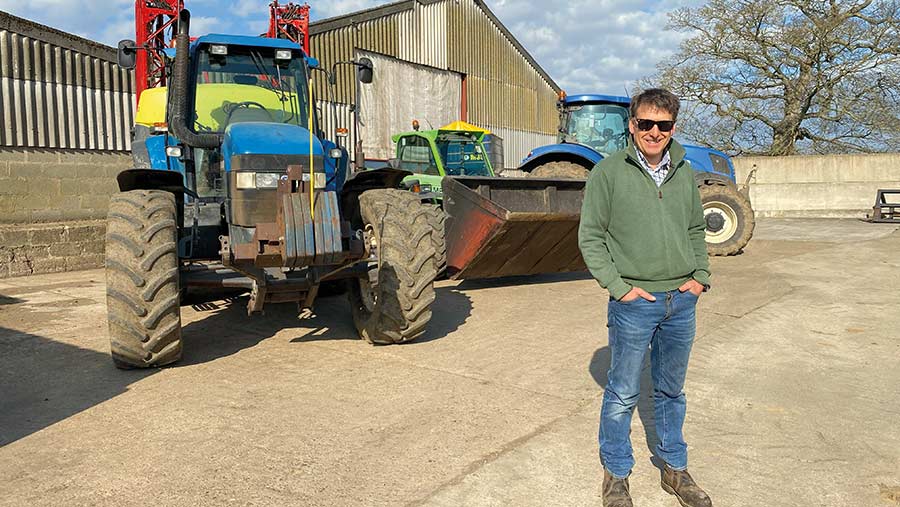 © MAG/Oliver Mark
© MAG/Oliver Mark North Yorkshire farmer Andrew Watson is the latest to open his shed doors in our monthly series.
Find out what farm machinery is in his shed and why he loves a blue tractor.
See also: Case and New Holland tractors: How to fix common problems
Farm facts: RP Watson and Son
- Farm size 200ha – 160ha arable, 40ha grass
- Cropping Wheat, oilseed rape, barley, oats
- Stock Sheep for summer grazing
- Staff Andrew Watson
How did you get started?
Our family has been in the parish for 140 years and I’m now the fifth generation.
The 200ha farm is mainly tenanted, although I did buy a small patch of land a few years ago.
We moved to this site in 1959, but have had the other half of the farm since the 1930s, and the estate has since put up two sheds, including a grain store.
Most of the land is arable, though I have a few sheep in the summer to graze areas along the riverbanks that are good for nothing else.
In the early days there was a bit more grass, but we ended up ploughing everything we could.
In the shed
- Tractors New Holland T7.210 Power Command (2013), 8360 (1998)
- Telehandler Merlo 32.6 (2008)
- Cultivation kit 3m Simba X-Press with ST Bar, 4.6m X-Press discs, Tim Howard five-leg subsoiler, 12m Vaderstad Cambridge rolls
- Drill 3m Vaderstad Rapid 300S
- Sprayer Vicon Ixter B13 with 24m boom and 1,300-litre tank
- Fertiliser spreader Bogballe M35
- Trailers 15t Bailey x2
- Other 20t Master dryer
How brand loyal are you?
We’ve always had blue tractors, except for a Massey Ferguson 165 in the 1970s, which was mechanically bulletproof but not as nice to drive as the equivalent Fords of its era.
I can’t see the point in changing brand – I’ve only got two tractors and it keeps servicing and maintenance simple.
Favourite dealer?
I just deal with whoever has what I want.
For tractors, I’m halfway between Russells’ yard and Lloyd at Bishop Auckland, and it was the latter that had the New Holland T7.210 in the spec that I wanted – so they got the business.
Spares tend to come from a new dealer called AgriSource, which is just down the road. Paul, who set it up, sold me the sprayer before he went off on his own, so I always get bits for that through him.
And I use Keith Tallentire, based a couple of miles away at Bishop Auckland, for any engineering jobs. He chipped my T7 a few years after I bought it, as I wanted a bit more power without having a bigger tractor.
As with all New Hollands, the engine boost wasn’t available for draft work and it tended to struggle pulling the Vaderstad drill up some of the hillier fields with a full tank of seed.
It now puts out 210hp and has loads more torque.
Favourite piece of kit?
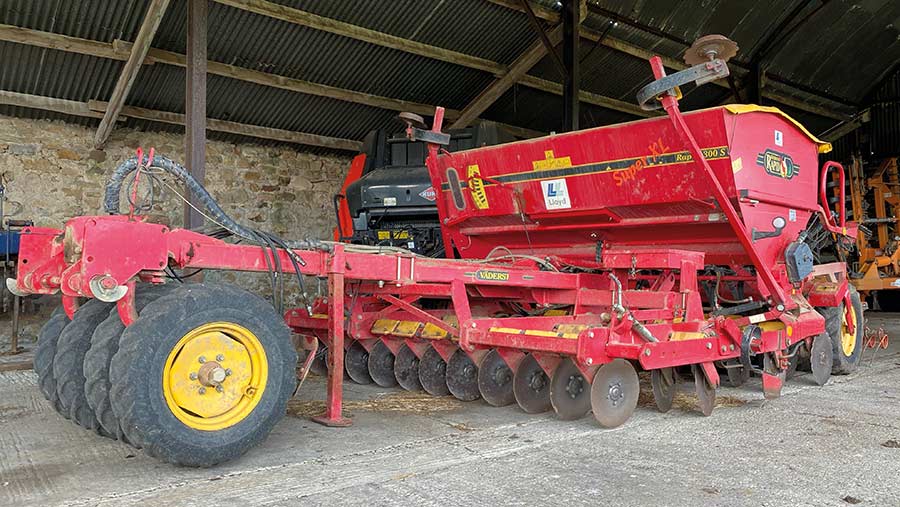
The Vaderstad Rapid has markedly improved crop establishment on Mr Watson’s stoney ground © MAG/Oliver Mark
The 3m Vaderstad Rapid drill. It’s so good at what it does, will reliably get seed into the ground and I can do 30ha in a day, which is priceless when I’m busy.
It was three years old when I bought it in 2007 and has now drilled more than 3,000ha. It cost a bit under £20,000 and is probably still worth over £10,000, so it has proved a good investment.
That said, I take good care of it, and it always gets a proper winter refurb.
I’ve changed the coulter discs twice and the system discs a couple more times, as they’re running on an angle into virgin ground and wear slightly quicker.
The only downside is that, when drilling oilseed rape, it needs a lot of seed in the hopper to make sure it comes out evenly.
As a result, I have to buy an extra bag of seed every year just to make sure I don’t have any problems.
Least favourite piece of kit?
There’s nothing I dislike using these days, but I can’t say the same about a Laverda M120 combine that I had for a while.
For some reason it had no more than half a dozen daily grease nipples as all the bearings were sealed. It was a joke, really, as all the time saved greasing was taken up by replacing shot bearings.
The 120hp Perkins engine kept seizing too, probably because it was so woefully underpowered.
In the 1980s it caught fire, which was the best thing that could have happened to it.
I now have AWSM Farming, a local contractor, to do the combining. They’ve got a couple of Lexions – a 670 and a new 6700, which was demoed here a couple of years ago.
The big one gets through the crop so fast I had to buy another trailer.
Latest purchase?
A three-year-old 15t Bailey trailer on flotation tyres, which came second-hand from Ripon Farm Services a year ago for £11,000. It replaced a dump trailer that I used to ferry muck in.
This one had been in East Anglia – it has a big “4” on the side, so everyone must think I’m running a huge outfit.
I’ve now got two 15t Baileys and I get on well with them. The flotation tyres are also far better than super-singles in the field.
Do you buy second-hand?
Usually. I have bought new stuff over the years but these days it’s mainly used stuff, especially given how expensive machinery is.
I also like the fact that a lot of my kit is no longer depreciating, and the 8360 is probably becoming a bit of a collector’s item.
Oldest machine still at work?
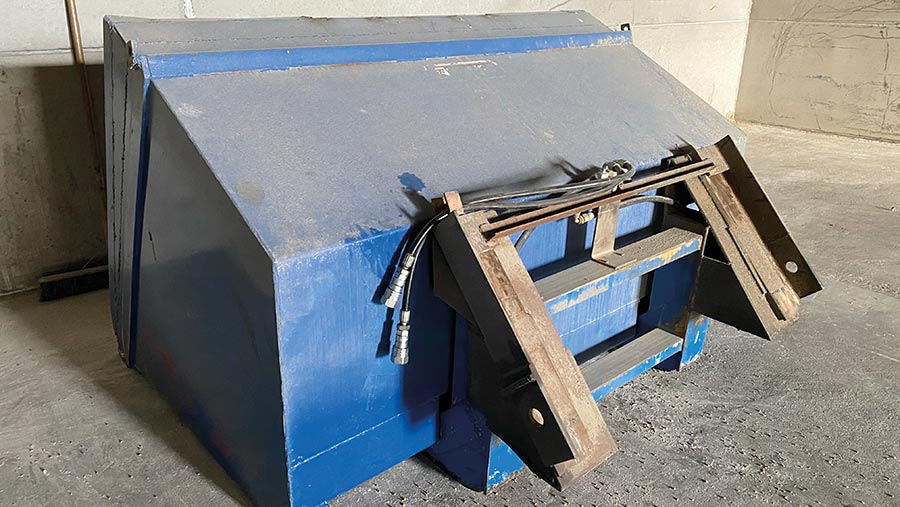
A 1986 Tanco toe-tip bucket that is used to load grain wagons © MAG/Oliver Mark
A Tanco toe-tip bucket, which I originally bought for a Sambron loader in 1986. It still loads all the grain wagons and has shifted tens of thousands of tonnes over the years.
I extended it to carry 1.75t and it is fitted with Sanderson brackets, as that’s what I’ve always had.
Because most of my attachments are quite old, it has been easier to specify Sanderson carriages than alter all the ones I already own. It might not be the best headstock, but it’s convenient.
How long do you keep your machines?
As long as they last, provided they’re doing a good job.
The 8360 is now 24 years old and on 8,500 hours, and it’s still going strong. It does all the spraying and is also big enough to do the drilling if necessary.
I service everything myself – it’s not hard to change the oils and grease up – and I hope that if I keep them right then they’ll last a good while longer.
Next on your wish list?
I’ve got no plans to make any big changes. It’s taken me 20 years to get fully geared up with the right size tractors and implements for the farm, and there’s nothing I really need.
Plus, the uncertainty of the future means I won’t be spending money for the sake of it.
Biggest machinery mistake/most embarrassing incident?
Not long after I left school, I was cultivating with a set of Massey Ferguson mounted discs. The plough had missed a bit near to a telegraph pole and, in a bid to tidy it up, I got as close as I could.
Unfortunately, the discs bit into the unploughed ground and dragged the cultivator into the pole, bending the main shaft and smashing the bearings.
The pole stayed upright, but the discs were a mess. It was out of action for days and, back then, it had to be sent to the local blacksmith to be sorted out.
Since then, the six telegraph poles in the field have been rerouted along the road, but I’ve learnt to steer clear of them anyway.
Most expensive repair bill?
A shaft snapped in the T7’s Power Command gearbox while I was subsoiling tramlines last year.
I was tootling along happily, but the legs must have hooked underneath a massive stone and it stopped the tractor dead without the auto reset system triggering.
The middle gears were out of action, but I managed to whizz home in high range.
Keith Tallentire, a local engineer, did the repair work over two weeks. Thankfully, I was well on with the drilling at the time, but it still cost thousands of pounds to fix – mainly in labour.
Most overpriced spare part?
I recently replaced two relatively short but unusually shaped hoses that connect to the radiator on the Merlo – one was £90 and the other was £180.
I only changed them as the radiator was leaking and, when I’d repaired it, noticed that they’d gone hard and weren’t sealing very well.
Merlo spares tend to be pretty expensive at the best of times, and they were no exception.
Best invention?
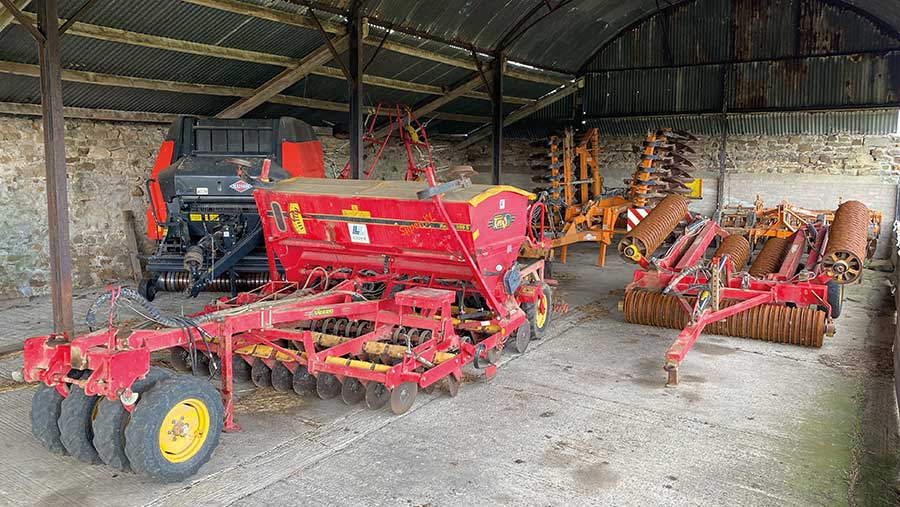
Tillage tools include two Simba X-Press cultivators and a set of 12m Vaderstad rolls © MAG/Oliver Mark
A front toolbar for the Vaderstad Rapid, so I can establish oilseed rape crops in a single pass.
To do it, I used a frame that I’d originally built 20 years ago for picking up three-point linkage-mounted implements with the Merlo.
Keith Tallentire adapted it to fit on my standard Simba ST Bar, which is usually run on the X-press disc cultivator. It means it can mount between the tractor and drill to loosen the ground.
It took a bit of work to make sure the drill is carried at the correct height and the legs work deep enough, and I’ve found I have to set the system discs aggressively to level the furrows created by the ST legs.
Another small, but useful, modification was to double the length of the grain pusher by building an extension a couple of years ago.
Both the old and new elements are 2.4m long so, when joined together, I’ve now got a 4.8m reach. It seemed daft to make a whole new pusher when I could just adapt the original.
The dearest part was the headstock, which cost £450. Keith helped me out, as he has plenty of steel, cutting facilities and a mig welder.
What couldn’t you live without in the workshop?
My Milwaukee electric grease gun. I don’t have much fancy workshop gear, but it makes life so much easier and it never suffers from air locks.
The other thing I couldn’t live without is a DAB radio for Test Match Special and BBC 6 Music. You need something to listen to when you’re on your own all day.
Favourite job and least favourite job?
Drilling is my favourite. The Vaderstad Rapid does a great job and it requires a certain amount of concentration to operate, so isn’t as mind-numbing as cultivating can be.
I also like rolling when there aren’t too many stones to pick – it’s the worst job when there are.
I hate fencing. During the first lockdown, my daughter made us our own custom monopoly board but, instead of “go to jail”, it was “go fencing”.
The irony is that I can’t pin down a fencing contractor at the minute, as they’re all too busy.
What’s your everyday transport?
A 2.4-litre Toyota Hilux Invincible X, which arrived the day before lockdown. As a result, I’ve only done 11,000 miles in it, but it’s beautiful to drive.
I’ve also got a battered 19-year-old, 109,000-mile Mitsubishi L200 that used to be my main vehicle. It’s tax-exempt and runs on red, so I use it for nipping around the farm.
With chunky tyres it can get everywhere and is so much better than a quad bike.
Best tractor you’ve had?
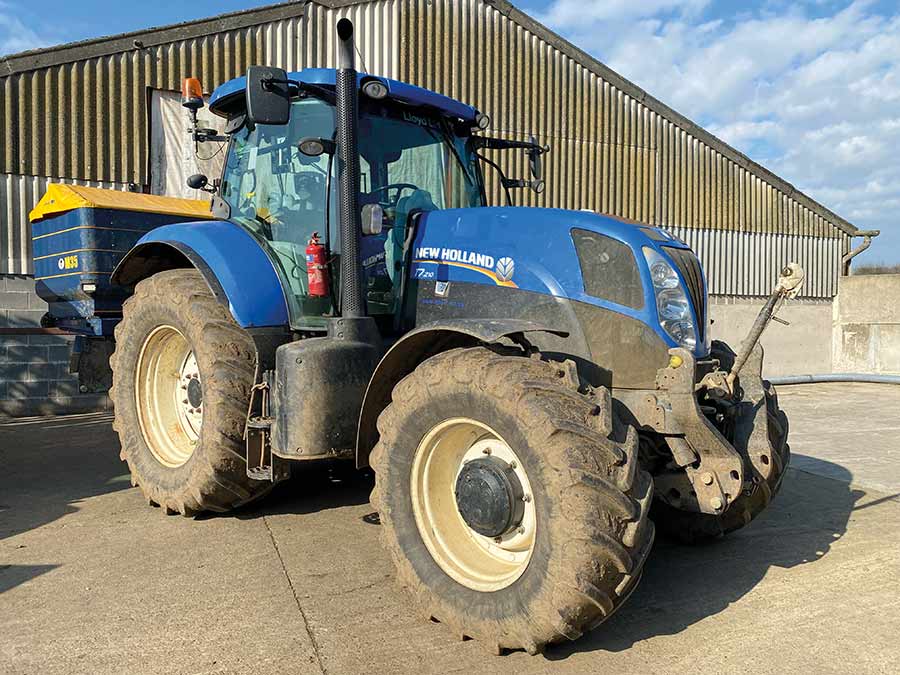
The New Holland T7.210 has been chipped to reliably put out 210hp © MAG/Oliver Mark
The T7.210 is great to drive, the transmission is smooth, and the suspension gives a good ride. Its only downside is the tiny button on the stalk to disengage the drive, which I think is a bit dangerous.
Its predecessor was a 2004 TM155, which I also really liked. I got almost as much as I paid for it when I traded it in, and my brother-in-law then bought it from the dealer.
He ran it for a bit, then sold it for the same price.
The Merlo is good too – the hydrostratic drive is slick and the fact that the cab is quite low makes it really easy to get in and out when sorting the dryer or filling grain wagons.
Worst tractor you’ve had?
I’ve had nothing really bad. The old MF 165 was probably the worst, as it had no power steering and wasn’t as nice as the Fords.
Biggest machinery bargain?
I had a 12t dump trailer than I ran for 20 years to ferry muck on a straw-for-muck deal. I sold it last year for £4,000, which is what I paid for it.
They’re obviously in demand and, to be fair, I had looked after it.
Another bargain was my loader bucket, which cost just £250 and all it needed was a new lip, which I welded on myself.
